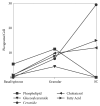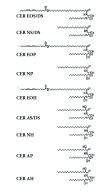Lipids and the Permeability and Antimicrobial Barriers of the Skin
- PMID: 30245886
- PMCID: PMC6139190
- DOI: 10.1155/2018/5954034
Lipids and the Permeability and Antimicrobial Barriers of the Skin
Abstract
The primary purpose of the epidermis of terrestrial vertebrates is to produce the stratum corneum, which serves as the interface between the organism and the environment. As such, the stratum corneum provides a permeability barrier which both limits water loss through the skin and provides a relatively tough permeability barrier. This provides for a degree of resistance to mechanical trauma and prevents or limits penetration of potentially harmful substances from the environment. The stratum corneum consists of an array of keratinized cells embedded in a lipid matrix. It is this intercellular lipid that determines the permeability of the stratum corneum. The main lipids here are ceramides, cholesterol, and fatty acids. In addition, the skin surface of mammals, including humans, is coated by a lipid film produced by sebaceous glands in the dermis and secreted through the follicles. Human sebum consists mainly of squalene, wax monoesters, and triglycerides with small proportions of cholesterol and cholesterol esters. As sebum passes through the follicles, some of the triglycerides are hydrolyzed by bacteria to liberate free fatty acids. Likewise, near the skin surface, where water becomes available, some of the ceramides are acted upon by an epithelial ceramidase to liberate sphingosine, dihydrosphingosine, and 6-hydroxysphingosine. Some of the free fatty acids, specifically lauric acid and sapienic acid, have been shown to have antibacterial, antifungal, and antiviral activity. Also, the long-chain bases have broad spectrum antibacterial activity.
Figures



Similar articles
-
Roles of Lipids in the Permeability Barriers of Skin and Oral Mucosa.Int J Mol Sci. 2021 May 15;22(10):5229. doi: 10.3390/ijms22105229. Int J Mol Sci. 2021. PMID: 34063352 Free PMC article. Review.
-
Permeability and lipid organization of a novel psoriasis stratum corneum substitute.Int J Pharm. 2013 Nov 30;457(1):275-82. doi: 10.1016/j.ijpharm.2013.08.086. Epub 2013 Sep 10. Int J Pharm. 2013. PMID: 24036087
-
The heterogeneity and complexity of skin surface lipids in human skin health and disease.Prog Lipid Res. 2024 Jan;93:101264. doi: 10.1016/j.plipres.2023.101264. Epub 2023 Nov 6. Prog Lipid Res. 2024. PMID: 37940006 Review.
-
Influence of the sebaceous gland density on the stratum corneum lipidome.Sci Rep. 2018 Jul 31;8(1):11500. doi: 10.1038/s41598-018-29742-7. Sci Rep. 2018. PMID: 30065281 Free PMC article.
-
Stratum corneum lipid abnormalities in atopic dermatitis.Arch Dermatol Res. 1991;283(4):219-23. doi: 10.1007/BF01106105. Arch Dermatol Res. 1991. PMID: 1929538
Cited by
-
Are the Cutaneous Microbiota a Guardian of the Skin's Physical Barrier? The Intricate Relationship between Skin Microbes and Barrier Integrity.Int J Mol Sci. 2023 Nov 4;24(21):15962. doi: 10.3390/ijms242115962. Int J Mol Sci. 2023. PMID: 37958945 Free PMC article. Review.
-
Enhancement of stratum corneum lipid structure improves skin barrier function and protects against irritation in adults with dry, eczema-prone skin.Br J Dermatol. 2022 May;186(5):875-886. doi: 10.1111/bjd.20955. Epub 2022 Apr 3. Br J Dermatol. 2022. PMID: 34921679 Free PMC article. Clinical Trial.
-
The Prevalence and Determinants of Hand and Face Dermatitis during COVID-19 Pandemic: A Population-Based Survey.Dermatol Res Pract. 2020 Dec 5;2020:6627472. doi: 10.1155/2020/6627472. eCollection 2020. Dermatol Res Pract. 2020. PMID: 33376481 Free PMC article.
-
DNA lipid nanoparticles as alcohol-sensitive surrogates to trace microbial transmission and monitor hand hygiene.Sci Rep. 2025 Jul 31;15(1):27965. doi: 10.1038/s41598-025-12040-4. Sci Rep. 2025. PMID: 40744956 Free PMC article.
-
Sphingolipidomics of Bovine Pink Eye: A Pilot Study.Vet Sci. 2022 Jul 28;9(8):388. doi: 10.3390/vetsci9080388. Vet Sci. 2022. PMID: 36006303 Free PMC article.
References
-
- Wertz P. W., Downing D. T. Stratum corneum: Biological and biochemical considerations. Transdermal Drug Delivery. 1989;35:1–22.
-
- Attenborough D. Life on Earth. Boston, Mass, USA: Little Brown & Company; 1980.
-
- KooymaN D. J. Lipids in the skin. Some changes in the epidermis during the process of keratinization. Archives of Dermatology and Syphilology. 1932;25(3):p. 444. doi: 10.1001/archderm.1932.01450020460003. - DOI
Publication types
LinkOut - more resources
Full Text Sources
Other Literature Sources
Research Materials

